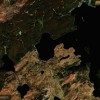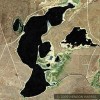
Connection Between The Horned Serpent (Snake) Myth Of North America and the Chinese Dragon
Posted on Friday, August 20th, 2010
In the beginning of Chinese history the snake, not the dragon, was the most significant Chinese totem but the snake was to evolve over the millennia into the dragon totem which “many Chinese people use.… as a sign of ethnic identity.…”. (Pages 1 & 2) Chinese Dragon.
“Some scholars have noted that a myth arose that the first legendary Emperor of China Huang Di (Yellow Emperor) used a snake for his coat of arms.” (Totem) I believe that this reference demonstrates the priority of the snake at this early time in Chinese history.
Using the snake as his base “everytime he conquered another tribe, he incorporated his defeated enemy’s emblem into his own….”  Page 3
Mythological Serpents/Dragons
“Sometimes serpents and dragons are used interchangeably, having similar symbolic functions.” Serpent (Symbolism) Page 3 of 13
North American Mythology
“In America some of the Native American tribes give reverence to the rattlesnake as grandfather and king of snakes who is able to give fair winds or cause tempest”.   Page 10 of 13
Please note the use of the word “grandfather” in this description. The Chinese also called this “dragon headed snake” grandfather which in Chinese is Pangu (the Chinese god of creation). Also note, this snake image had control over the weather. Another tie into the Dragon Myth. This is more evidence that the North American Horned Serpent is the Dragon Headed Snake, Pangu.
A major characteristic of the Dragon that is shared with the Horned Serpent in myths of North America is the belief that both these mythological beings have exceptional power and authority over weather particularly weather that has to do with water or the lack of it.
This includes:
- Rain
- Lightening
- Thunder
- Drought
- Waterfalls
- Rivers
- Seas
- Water Spouts
- Floods
The specificity of these shared powers and attributes of the North American Horned Serpent and the Chinese Dragon is remarkable. In my opinion then, to believe that these myths and cultures are not directly related requires a belief in coincidences that allows some to believe that the similar pyramids found in China, Southeast Asia, Central and South America and Egypt are also unrelated to each other.
Recently I have seen an interesting artifact purchased in Beijing just before the Olympics. It’s a stone carving in the form of a very old cannon. Many years ago, my father purchased and sold Chinese body plugs along with other Chinese antiquities, when I was living at home, so I recognize the body stains on a burial stone when I see it and this cannon has body staining all over it. But what makes this burial stone interesting is that it has uninterpreted ancient Chinese script along the top of the barrel with a separate image of the dragon headed snake Pangu (North American Horned Serpent) on both sides of the barrel. On both sides of the cannon carriage is a beautiful depiction of a parrot. (South America?)  This stone cannon raises a number of interesting questions. I may be able to post pictures of this cannon in the near future.
The Beak of the 10th Sun Raven STILL GLOWS!

















